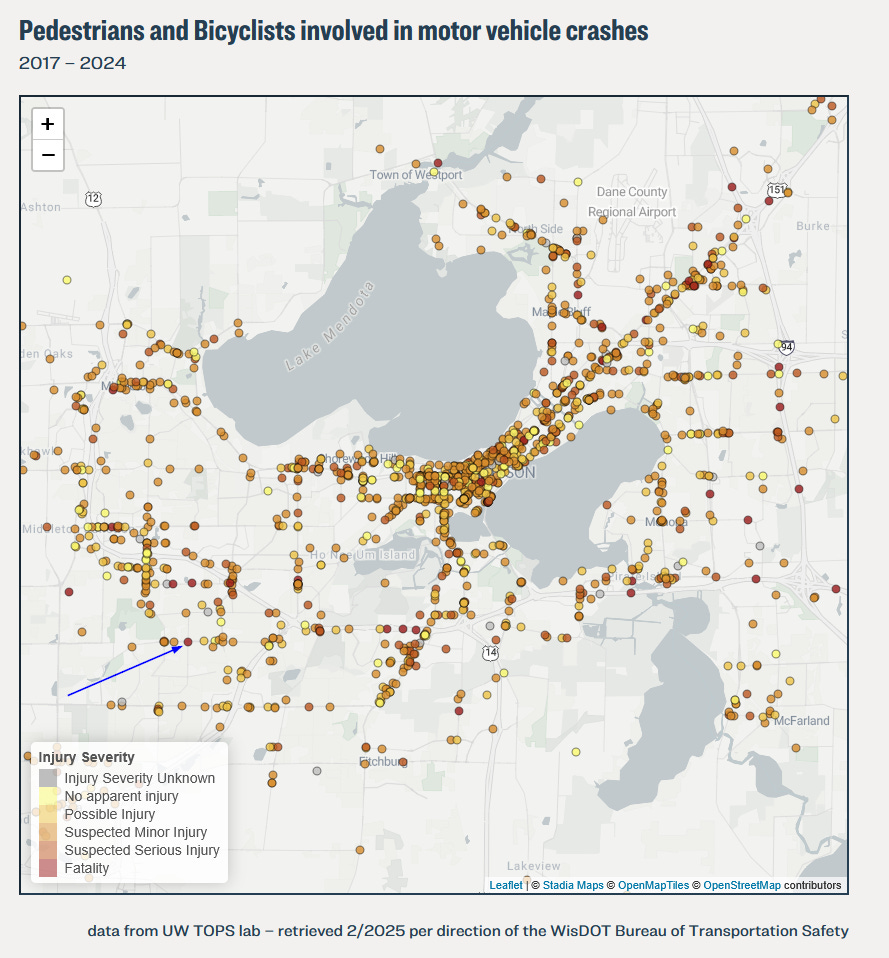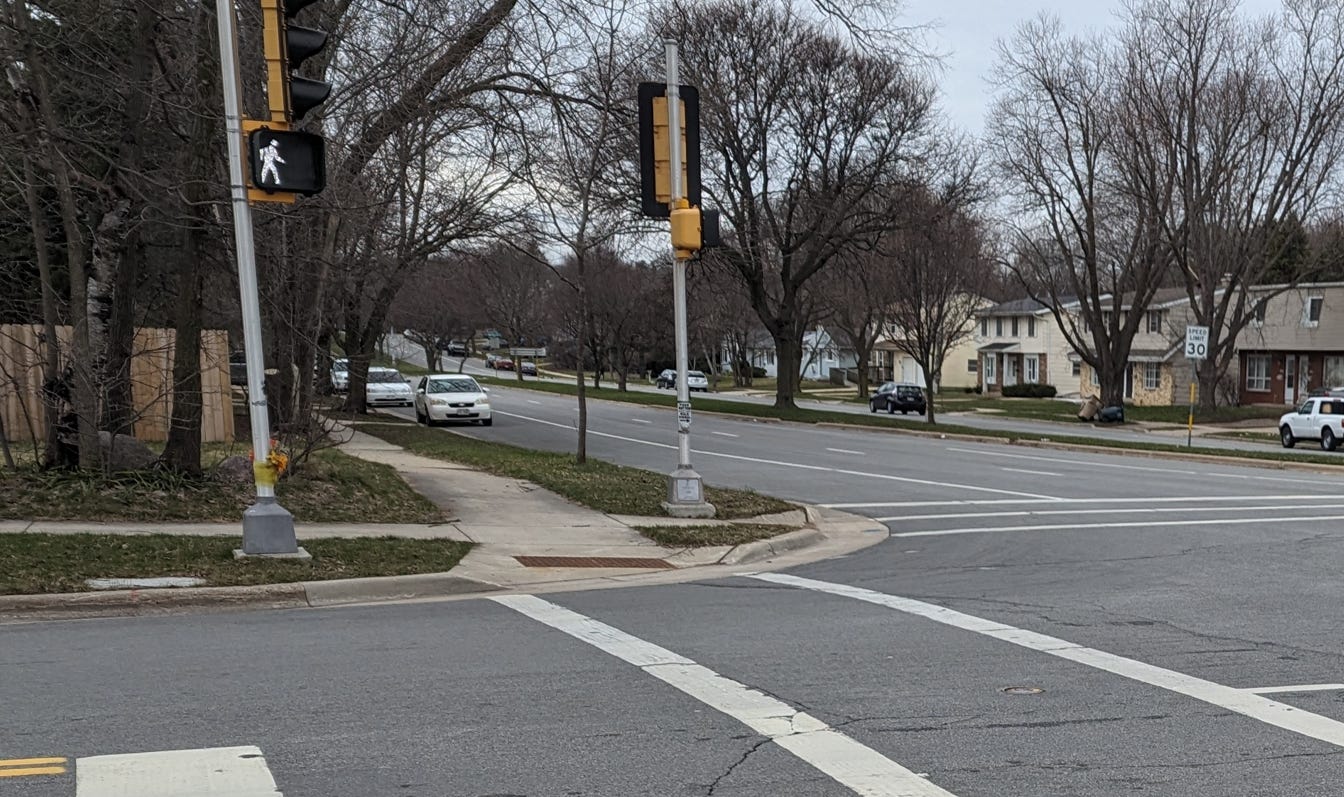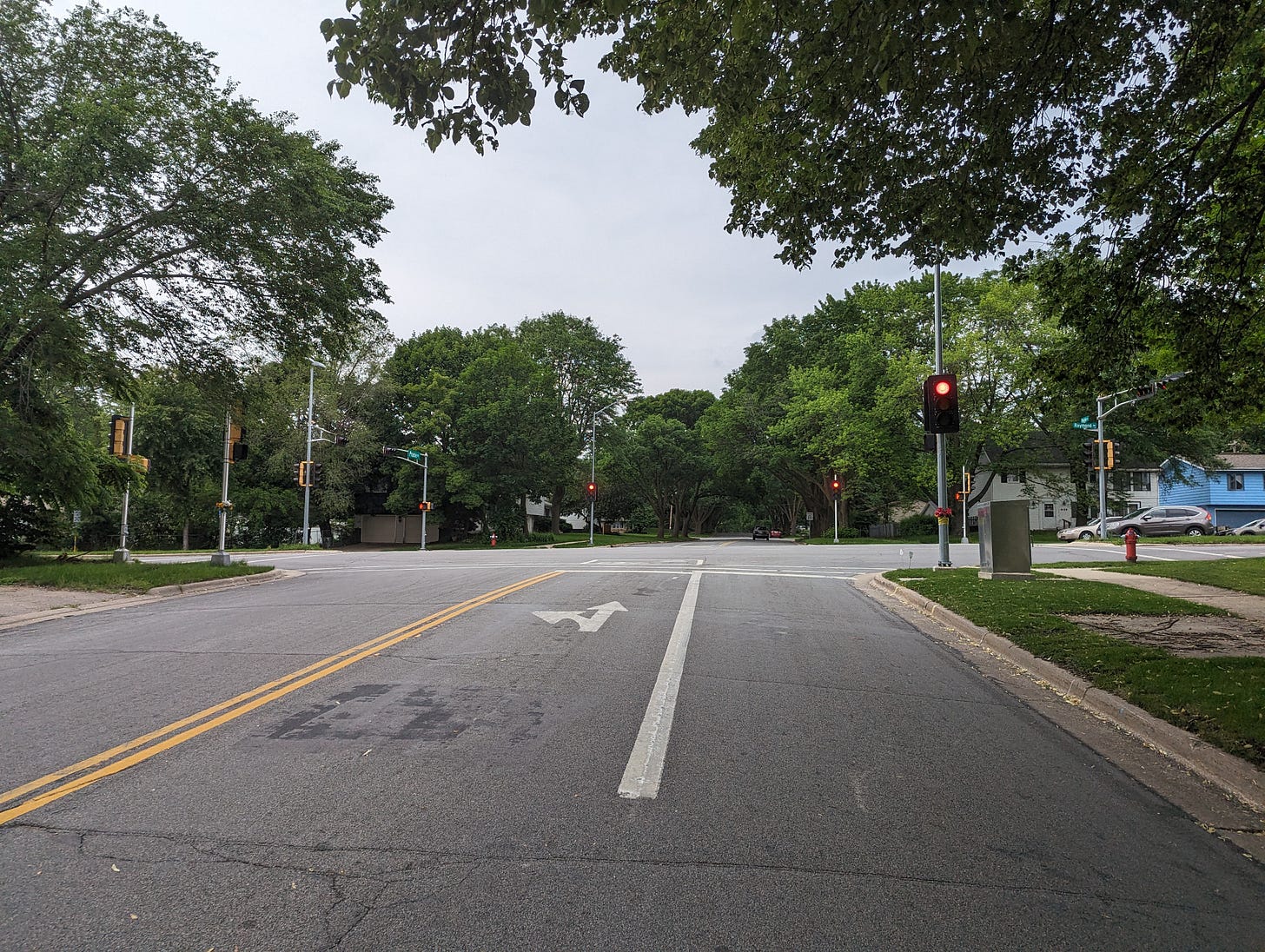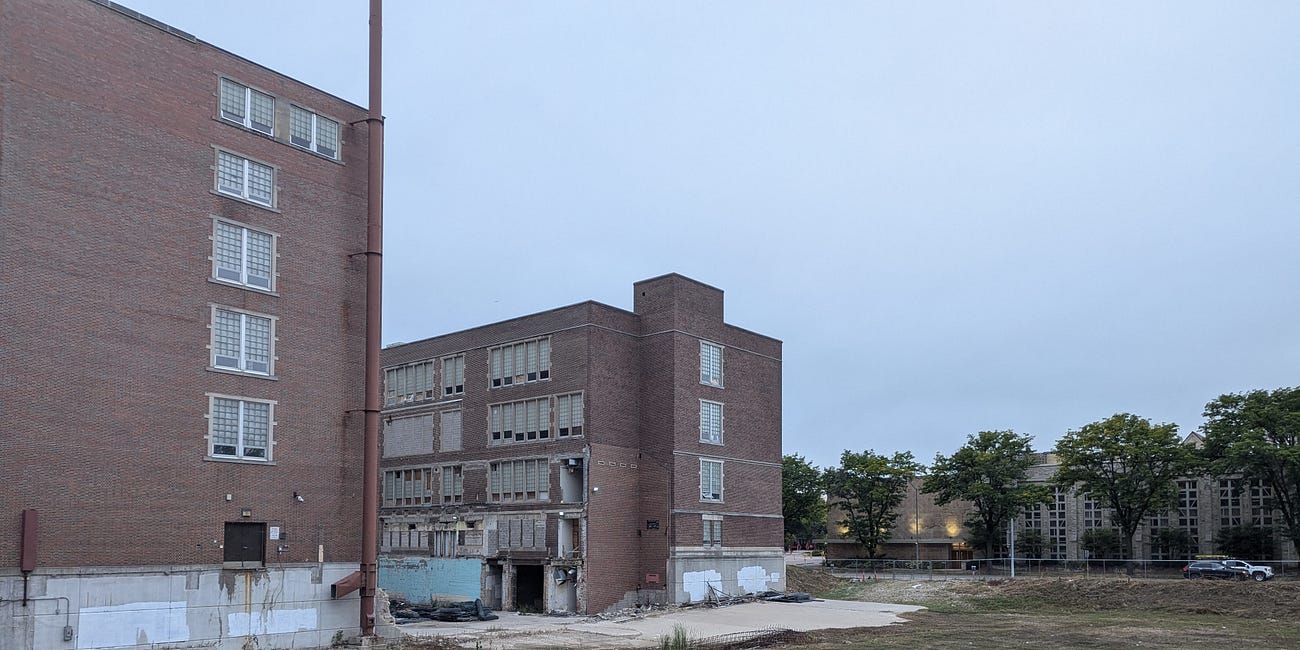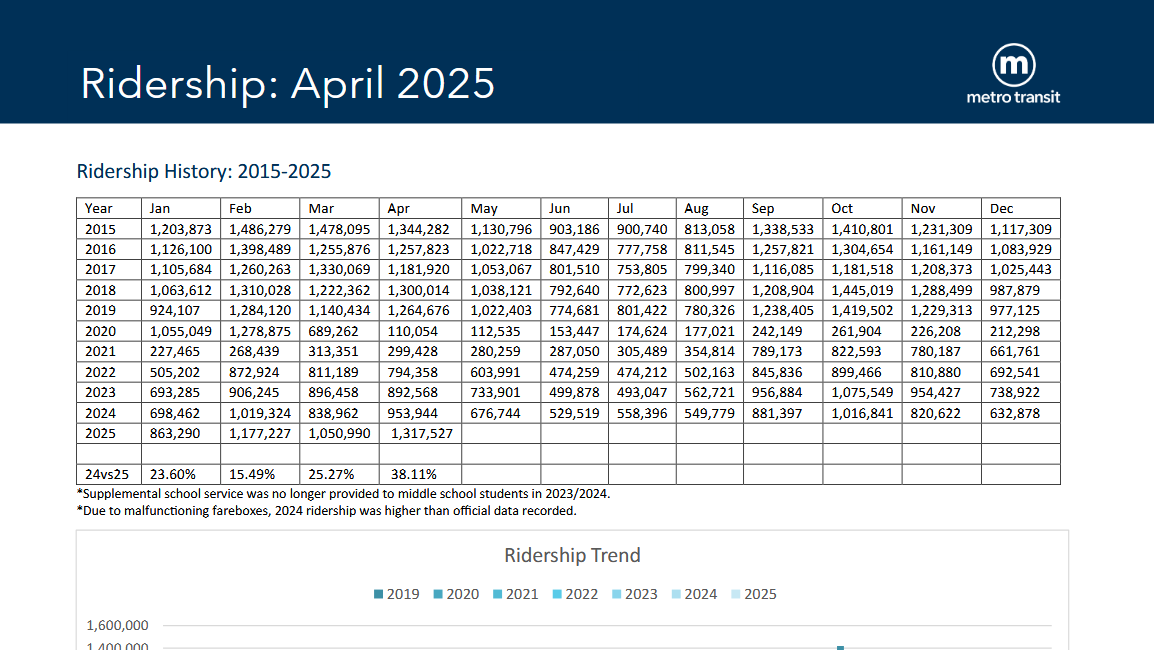I hosted a Crash Analysis Studio for Madison
Taking "no person should be the second person to die on a dangerous street" to heart
A lot of car crashes are preventable, but here in the U.S we do not take serious efforts to prevent them. Over 40,000 Americans die from car crashes each year. Most of the population knows someone who was seriously injured or died as the result of a car crash. The heartbreaking crashes involve people who had no control over the incident, as pedestrians, bikers, passengers, or drivers in other vehicles who otherwise are following the law.
As someone who takes most modes of transportation1, I’ve gotten to experience all kinds of traffic infrastructure in Madison. There is no better feeling than exploring your City outside of a vehicle. Everything scales to your level and you can spend time looking at things that would otherwise pass at 35+ mph. Earlier this summer I biked to the grocery store on the East side and I got to watch the Fool’s Flotilla, associate in my memory where the new Public Market is physically located, and explore housing types in a North Street neighborhood on a relatively low stress bike path and bike boulevard route.
Everything was great until I arrived at Aberg Avenue, a Highway 30 four-lane offshoot that severs the North Street neighborhood from a Pick ‘n Save.
When I arrived, the traffic system had failed. The traffic lights were broken and cars decided that the lack of a red light meant it was now a highway. I moved back several feet, called the Madison non-emergency line, and I was informed the engineers would be arriving soon if they weren't already there; they had been dispatched about an hour earlier.
I waited for a large gap. This road has a speed limit of 45 mph but most cars drive faster than that. Technically, there's an “island” where cars turn left onto Shopko Drive. But it's very thin and not really designed for an e-bike. I saw my gap, I quickly jetted across the street, and dreaded having to do it again after picking up groceries (I did end up doing this 15 minutes later).
I know my traffic tolerance is higher than most, but this was terrifying. I nearly turned back after seeing a bouquet of flowers on the traffic pole. For those who don't know, white bikes or bouquets of flowers attached to traffic infrastructure or near streets are memorials for people who died from car crashes. Within a few minutes of searching, I found the crash that killed a woman back in 2023. This is a dangerous street for people trying to cross it. How long will we wait until another person dies a needless death?
Back in 2023, a high school classmate of mine tragically died standing on the sidewalk as a drunk driver drove off the road. The driver was supposed to have an ignition interlock system that would prevent him from driving under the influence. I read articles from the local neighbors who had been complaining about this section of road for over a decade. It was too fast, there were countless incidents including two crashes with pedestrians in the previous eight days, and a crossing guard was hit in 2021. Despite using two systems (the interlock and public feedback), tragedy was not prevented. These systems failed and fail Americans on a daily basis. Having been a Strong Towns member for around a year at that point, I reached out about helping with a Crash Analysis Studio (CAS). The neighbors were terrified and something needed to be done.
Unfortunately, the analysis requires a lot of on the ground data collecting. I was here in Madison and it was unrealistic for me to help. But I was told to reach out again if there was something in Madison that would make for an informative studio. I knew that East Washington had its spree of fatalities in 2021 (six deaths, 2,600 traffic citations) and I landed on the Wisconsin Bike Fed Pedestrian Crash Map. This map shows every crash involving a pedestrian since 2014 and measures them by severity:
That blue arrow points to a fatality that occurred two blocks from my apartment just two months prior. I did not hear about this fatality; there was no media coverage because it did not make the Madison Police Incident Report. However, when I walked to the intersection of Raymond and Prairie I saw the bouquet:
I contacted Strong Towns again and I gave them the context. Raymond Road, an underdeveloped four lane road with some hills and nearly a mile of straightaway, has had multiple fatalities. As a truck route and a bus route, the lanes are wider and parking lanes run all along the street. There are three signalized intersections in this area, one being Prairie Road. This specific intersection is located near two elementary schools, a library, and many homes. I biked along this route frequently and was “buzzed” like a fighter jet several times by speeding vehicles. When I obtained a redacted police report, the crash was a “right on red” where the van turning right onto Raymond (from Prairie) failed to see the pedestrian crossing the path in front of them from the right. Strong Towns sent me a starter pack for analysis and I got to work on the data collection.
On a cloudy day in April, I sat in my parked car for two hours, recording the speeds of all the cars that passed. Raymond Road has a posted speed limit of 30 mph. My question to you:
I will reveal the answer in a bit; please make an honest guess. I lived on this street. It was not surprising to me because I could hear the cars at night. A few days before the Crash Analysis aired, I happened to see some police officers conducting their own speed enforcement down the road from the intersection. I pulled over and chatted with them for about 15 minutes, talking about the CAS and asking them about speeding in general. They said they routinely caught vehicles traveling within 5 mph of my recorded speed. My data point was not an anomaly in the grand scheme of things. It would definitely be the maximum for the day, but it was par for the course to catch at least one driver nearing that speed on a daily basis.
…
The answer is below this line.
…
73 mph.
This only made me more determined. I measured street widths, performed another speed study on Prairie Road, this time catching speed and also the number of vehicles making proper right turns onto Raymond2. Of the 96 drivers that turned right onto Raymond in the two-hour period, only five made an appropriate turn. Four of the drivers had a green light, leaving a single driver who stopped correctly at the red light. They also happened to be a Strong Towns Madison member dropping off the radar gun.
91 drivers made an inappropriate right turn. They either stopped beyond the line or just didn’t stop at all. Every car nudged into the crosswalk. If this doesn’t make sense to you, here’s the intersection from the vantage point of a vehicle.
Cars could not see vehicles flying down Raymond to their left. There’s a large signal box to the right that can block the view of a pedestrian (we witnessed this our selves!). Every car focuses on the sedan/truck/delivery truck going 40+ mph to ensure they aren’t in danger, putting pedestrians with the right of way and following the law in jeopardy.
The Crash Analysis Studio was eye opening to me. Edward Erfurt happened to be in Madison for a housing conference, so we were able to meet and walk the scene. He provided valuable insight that a civilian like me doesn’t even consider: the steep incline up to the intersection, the signal box, and the tree to the left—all reducing visibility. We had an hour long discussion (you can watch it here!) with technical experts and the local neighborhood association president. I got to meet with City Staff to discuss it in detail and walk the site with them. It was picked up by Transportation Commission where we had further discussion (presentation located here). I didn’t get everything that I wanted, but the City did daylight the left side by cutting down an inappropriately planted tree, removed foliage from a different tree covering the traffic lights, and added a (sadly unenforceable) “No Turn on Red” sign.
Ideally, the City would experiment with reducing Prairie to a single lane. The right turn lane acts as a slip lane (as we witnessed) and the amount of traffic doesn’t warrant needing an additional lane. They can reduce the light cycles on Raymond, allowing for Prairie traffic to move through. I don’t know if this is the right permanent change, but I wish there was more appetite for testing ideas. If it was a colossal failure after four hours of observation, mark that down and don’t do it again. If it seems to be working, extend the test. Credit where it’s due, the City did just that by reducing West Washington at the Southwest Commuter Path to a single lane each way. There was a interim test, the feedback was mostly positive, so they made it permanent. We should maintain that attitude for experimenting as we continue to reduce these crashes and fatalities. If the City wants to take the next step, there are more recommendations in the report on the first 18 Crash Analysis Studios.
Who’s to blame?
In these scenarios, the focus should not be on blaming anyone in particular. These analyses do not exist to put someone in jail or create cause for reviewing the license of a traffic engineer. The important part is to walk away with actionable improvements we can make to the design of the street.
Education doesn’t work. There are “Drive Slow” signs all over Madison and yet cars ignore them all the time. Further down on Raymond Road, there’s a radar speed sign that displays to all drivers that they are going beyond the speed limit (next to a school, too).
Enforcement doesn’t work. The officers I talked to were going out repeatedly and yet people continued to speed. Additionally, Madison police have stated that in increased enforcement areas where speeding does decrease, it lasts only as long as the resources exist to enforce it. When the officers move to a new intersection, drivers revert back to illegal speeds.
I’m a believer in physics. There are things we can do to make the driving environment more hostile to recklessness. Thinner streets, bollards, curves, bumps, you name it. Make it so people need to focus to drive. People feel comfortable driving above the speed limit because the road feels like it can handle higher speeds. If you take that feeling away, people will drive the correct speed.
Raymond Road saw another fatality earlier this year. It’s too late to say “no person should be the second person to die on a dangerous street”, but it’s not too late to say another person shouldn’t have to die.
More from Counting Cranes
Can Madison "see the cat"?
There are too many underused lots in Madison, especially in high productivity areas like Downtown. What can we do to prevent speculation and build things that are meaningful to Madisonians?
Walking, biking, e-biking, busing, driving, longboarding
I had help from a friend on this one




